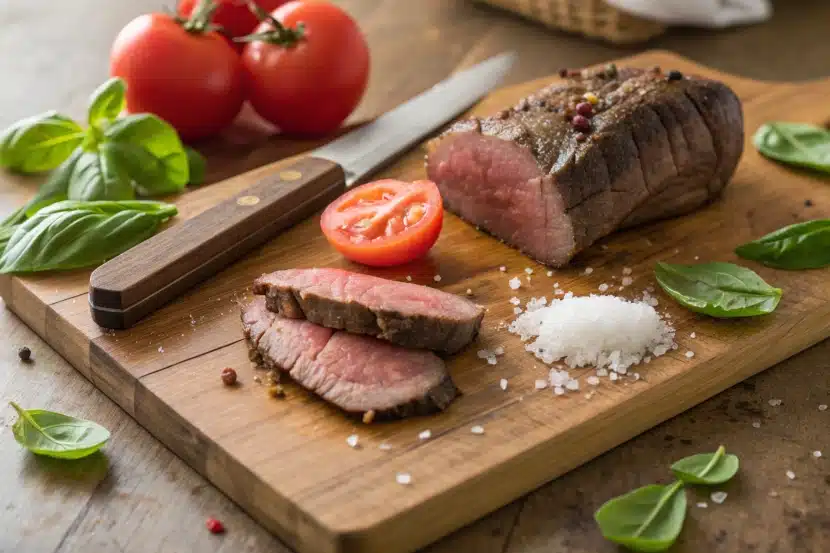When tomatoes are part of the story, one variety stands out for its size, taste, and versatility—the beef tomato. Known for its strong flavor, meaty texture, and bold appearance, the beef tomato wins over home cooks, gardeners, and professional chefs alike. This article explores the world of beef tomatoes, covering their unique traits, growing methods, culinary uses, and how they compare to other types of tomatoes. Whether you’re a food lover, a gardening enthusiast, or just curious, this guide has all you need to know.
What is a Beef Tomato?
A tomato based on beef, also called the beefsteak tomato, is one of the most popular kinds of tomato. Its enormous size and rugged, fleshy inner make it suitable for cutting, grilling, and serving sandwiches. Unlike more petite tomatoes, beef tomatoes are less liquid and have a distinct flavor similar to steak. This is the reason they’re referred to as beefsteak tomatoes. They are available in shades ranging from traditional red to orange and even pinkish hues.
Why is it Called a Beef Tomato?
The term”beef tomato” isn’t a tactic to promote a product. It was given to this particular tomato due to its weight and bulky texture. Contrary to cherry or plum tomatoes, the beef tomato is the perfect choice for a full dinner. Its thick, dense walls and small seeds make it ideal for dishes that need strength and structure.
Brief History and Classification of Beef Tomatoes
Beef tomatoes have a long and rich history that spans the 19th century. They come from South America and were cultivated for their size and flavor. Solanum, their botanical name, Lycopersicum, classifies them. They were once thought of as an individual species; however, nowadays, they’re grouped with other tomatoes. They are now a majority in all gardens around the world and are an example of the art of selective breeding.
Characteristics of Beef Tomatoes
Physical Features: Size, Color, and Texture
Beef tomatoes are a feast for the eyes. They can weigh over a pound, making them some of the largest tomatoes. Their colors range from deep red to pink, orange, or even striped. The flesh is firm and meaty with fewer seeds, which makes them great for recipes where a solid texture matters.
Taste Profile: What Makes it Unique?
The flavor of a beef tomato balances sweetness with a mild tang. This makes them ideal for both savory and sweet dishes. Unlike smaller, juicier tomatoes, their dense flesh gives meals a rich and satisfying taste.
Nutritional Value and Health Benefits
Beef tomatoes are packed with nutrients. They’re full of vitamins A, C, and K, as well as potassium and fiber. Their lycopene content, a powerful antioxidant, promotes heart health and may reduce the risk of certain cancers. Whether you eat them raw or cooked, they’re a healthy addition to your meals.
Cultivating Beef Tomatoes
Growing Conditions: Soil, Climate, and Watering Needs
The appropriate conditions are required to ensure the health of your beef tomato plants. They require fertile, well-drained soil with a pH range of 6.0 to 6.8. The sunny, warm environment is ideal for them, as they thrive with temperatures that range from 70degF up to 85degF. Regular watering and avoiding oversaturation are vital to avoid root decay.
Indeterminate vs. Determinate Varieties
Most beef tomatoes are indeterminate, meaning they grow and produce fruit throughout the season. This makes them a favorite for gardeners who want a steady harvest. Determinate varieties, which produce all their fruit at once, work well for small spaces or short growing seasons.
Tips for a Successful Harvest
Start seeds indoors 6-8 weeks before the last frost. Once they’re sturdy, plant them outside, spacing them about 24 inches apart. Support the plants with stakes or cages to hold the heavy fruit. Prune lower leaves for better air circulation and to prevent disease. With care, you’ll enjoy a summer filled with juicy beef tomatoes.
To get ideas about using your surplus, Try recipes like tomato soup from Flavory Cook.
Culinary Uses of Beef Tomatoes

What Are Beef Tomatoes Best Used For?
Beef tomatoes shine in dishes where structure and flavor matter. Their large, firm slices make them perfect for sandwiches and burgers. They also hold up well in salads, maintaining their shape under dressings.
When cooked, beef tomatoes add depth to soups and sauces. Their natural sweetness intensifies when roasted, making them a standout in stuffed tomato recipes or baked casseroles.
Popular Recipes Featuring Beef Tomatoes
There are countless ways to use beef tomatoes in the kitchen. Try stuffing them with rice, herbs, or ground meat for a hearty meal. Another popular choice is tomato caprese—a simple dish where thick tomato slices are layered with mozzarella, basil, and balsamic drizzle.
For something heartier, roast them and serve as a pizza or focaccia topping. Their slow-cooked flavor enhances any meal, whether served as a side dish or the main attraction.
Substitutes for Beef Tomatoes in Recipes
If you can’t find beef tomatoes, more heirloom varieties or Roma tomatoes could be a good addition to the gaps. While they may not have the same texture or meatiness, they provide the same delicious flavor. It is crucial to select tomatoes with a firmer texture when cooking recipes that require the solidity of a tomato, such as filling tomatoes.
To discover more tasty tomato-based recipes, try this incredible pizza toast, which provides new ways to utilize fresh tomatoes.
Differences Between Beef Tomatoes and Other Tomato Varieties
What is the Difference Between Tomatoes and Beef Tomatoes?
All tomatoes may share common roots, but beef tomatoes stand out for their size, firmness, and uses. Unlike smaller, juicier types like cherry or plum tomatoes, beef tomatoes are ideal for recipes requiring a hearty, meaty texture.
Beefsteak Tomatoes vs. Other Common Varieties
Compared to other tomatoes like Roma or grape varieties, beef tomatoes are the most versatile. Roma tomatoes work best for sauces due to their flesh-to-seed ratio, while cherry tomatoes are great for snacking. When it comes to slicing, grilling, or baking, beef tomatoes take the crown.
Unique Selling Points of Beef Tomatoes
Beef tomatoes stand out due to their steak-like, meaty flavor. Their ability to maintain their shape even when heated is an advantage when baking dishes. Additionally, the tomatoes’ natural sweetness shines when cooked. When cooked, grilled, or eaten fresh, fresh beef tomatoes impart a delicious and earthy flavor to any meal.
For more details on pairing beef tomatoes with flavor, Take a look at Flavory Cook’s sizzle steak recipes guide, which also includes complimentary meals for your table.
FAQs About Beef Tomatoes
Why is it Called a Beef Tomato?
“The word “beef tomato” is due to its vast size and meaty, thick texture, which makes it stand out from other varieties. The flesh of the tomato is supple and spongy. It resembles the bulk and weight of beef. It’s a great choice if you’re searching for tomatoes that will hold their shape during cooking, like sandwich recipes or baked tomatoes.
What Are Beef Tomatoes Best Used For?
Beef tomatoes can be used in various ways and work well in dishes that require flavor and structure. Large slices of beef tomatoes create the perfect juicy and firm layer for sandwiches and hamburgers. They are also great for roasting, stuffing, and grilling. The balanced flavor profile of these tomatoes is ideal for anything from fresh salads to rich casseroles.
What is the Difference Between Tomatoes and Beef Tomatoes?
While all tomatoes share the same genetic lineage, beef tomatoes differ in size, texture, and use. In contrast to smaller, less sweet varieties like plum and cherry tomatoes, beef tomatoes are larger and contain less liquid. This makes them ideal for cooking recipes that require the toughness of a tomato, such as roasting or filling dishes.
What is a Beefy Tomato?
A beefy tomato stands out for its firm texture and large size, traits that come from the beef tomato variety. The term highlights their ability to deliver a rich, meaty flavor in vegetarian dishes. This quality makes them a popular choice in meatless meals where both texture and depth of flavor are essential.
To get more ideas for recipes and cooking tips, look at Flavory Cook’s recipe guide for delicious beef steak recipes thinly cut with fresh tomatoes.

Environmental and Economic Importance of Beef Tomatoes
Role in Agriculture and Market Demand
Beef tomatoes are more than just a kitchen staple; they play a vital role in agriculture. Their popularity drives high demand among homeowners and commercial gardeners. Thanks to their large size and versatility, markets often price beef tomatoes at a premium, especially during the peak summer season.
Environmental Impact of Tomato Farming
Producing tomatoes in a sustainable manner can be beneficial for ecological balance. Methods such as crop rotation, organic farming, and organic fertilizers can lessen the impact on the environment of the tomato plantation. Additionally, beef tomatoes, because of their size, produce higher yields of food-grade produce per berry and reduce the amount of waste.
Innovations in Beef Tomato Cultivation
Recent advances in agriculture have created new resistance to diseases that cause beef tomatoes. These advances increase yields and reduce the need for pesticides containing chemical components, making it easier for farmers to grow healthier crops. Hydroponic systems and greenhouse farming are also becoming more popular, allowing year-round cultivation and conserving water and land.
For a deeper dive into sustainable recipes and methods, check out Flavory Cook’s collection of eco-friendly and delicious ideas, including tomato soup recipes using cherry tomatoes.
Final Thoughts
Why Beef Tomatoes Are a Culinary and Agricultural Treasure
The beef tomato is more than just a kitchen staple; it symbolizes variety and flavor. Its thick texture, bold taste, and ability to enhance countless recipes make it a favorite among food lovers. Whether you use it fresh, bake it, or grill it, the beef tomato always elevates your meal.
Encouragement for Readers to Try or Grow Beef Tomatoes
If you’ve not been impressed by the flavor of a beef-based tomato, this is the perfect opportunity to give it a try. Whether you grow the tomatoes in your garden or buy them from your local market, they will be a total delight for cooking. Explore new recipes, understand the benefits of tomatoes for health, and appreciate their distinct flavor. Food adventures will never be the same!
Final Notes
Examining the beef tomato will reveal its incredible impact on tableware and the garden. The tomato always inspires you when you’re enjoying the fresh flavor of sandwiches or studying its significance in sustainable farming. To get more ideas for cooking, check out Flavory Cook’s selection of practical recipes and recipes for beef tomatoes. Let the flavors of beef tomatoes assist you in creating your following fantastic recipe!


1 thought on “All About Beef Tomato: Nutrition, Uses, and Cultivation”